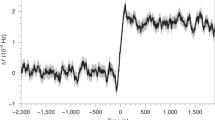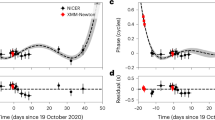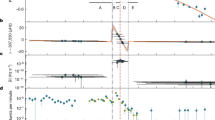Abstract
As pulsars lose energy, primarily in the form of magnetic dipole radiation, their rotation slows down accordingly. For some pulsars, this spin-down is interrupted by occasional abrupt spin-up events known as glitches1. A glitch is hypothesized to be a catastrophic release of pinned vorticity2 that provides an exchange of angular momentum between the superfluid outer core and the crust. This is manifested by a minute alteration in the rotation rate of the neutron star and its co-rotating magnetosphere, which is revealed by an abrupt change in the timing of observed radio pulses. Measurement of the flux density, polarization and single-pulse arrival times of the glitch with high time resolution may reveal the equation of state of the crustal superfluid, its drag-to-lift ratio and the parameters that describe its friction with the crust3. This has not hitherto been possible because glitch events happen unpredictably. Here we report single-pulse radio observations of a glitch in the Vela pulsar, which has a rotation frequency of 11.2 hertz. The glitch was detected on 2016 December 12 at 11:36 universal time, during continuous observations of the pulsar over a period of three years. We detected sudden changes in the pulse shape coincident with the glitch event: one pulse was unusually broad, the next pulse was missing (a ‘null’) and the following two pulses had unexpectedly low linear polarization. This sequence was followed by a 2.6-second interval during which pulses arrived later than usual, indicating that the glitch affects the magnetosphere.
This is a preview of subscription content, access via your institution
Access options
Access Nature and 54 other Nature Portfolio journals
Get Nature+, our best-value online-access subscription
$29.99 / 30 days
cancel any time
Subscribe to this journal
Receive 51 print issues and online access
$199.00 per year
only $3.90 per issue
Buy this article
- Purchase on Springer Link
- Instant access to full article PDF
Prices may be subject to local taxes which are calculated during checkout





Similar content being viewed by others
References
Rees, M. J. & Trimble, V. L. Physical sciences: planet, pulsar, “glitch” and wisp. Nature 229, 395–396 (1971).
Anderson, P. W. & Itoh, N. Pulsar glitches and restlessness as a hard superfluidity phenomenon. Nature 256, 25–27 (1975).
Sourie, A., Chamel, N., Novak, J. & Oertel, M. Global numerical simulations of the rise of vortex-mediated pulsar glitches in full general relativity. Mon. Not. R. Astron. Soc. 464, 4641–4657 (2017).
Biggs, J. D. An analysis of radio pulsar nulling statistics. Astrophys. J. 394, 574–580 (1992).
Johnston, S., van Straten, W., Kramer, M. & Bailes, M. High time resolution observations of the Vela pulsar. Astrophys. J. 549, L101–L104 (2001).
Rankin, J. M. Toward an empirical theory of pulsar emission. III - mode changing, drifting subpulses, and pulse nulling. Astrophys. J. 301, 901–922 (1986).
Sedrakian, A. & Cordes, J. M. Vortex-interface interactions and generation of glitches in pulsars. Mon. Not. R. Astron. Soc. 307, 365–375 (1999).
Krishnamohan, S. & Downs, G. S. Intensity dependence of the pulse profile and polarization of the Vela pulsar. Astrophys. J. 265, 372–388 (1983).
van Straten, W. & Bailes, M. DSPSR: digital signal processing software for pulsar astronomy. Publ. Astron. Soc. Aust. 28, 1–14 (2011).
Hotan, A. W., van Straten, W. & Manchester, R. N. PSRCHIVE and PSRFITS: an open approach to radio pulsar data storage and analysis. Publ. Astron. Soc. Aust. 21, 302–309 (2004).
van Straten, W. High-fidelity radio astronomical polarimetry using a millisecond pulsar as a polarized reference source. Astrophys. J. Suppl. Ser. 204, 13 (2013).
Hobbs, G. B., Edwards, R. T. & Manchester, R. N. TEMPO2, a new pulsar-timing package–I. An overview. Mon. Not. R. Astron. Soc. 369, 655–672 (2006).
Edwards, R. T., Hobbs, G. B. & Manchester, R. N. TEMPO2, a new pulsar timing package–II. The timing model and precision estimates. Mon. Not. R. Astron. Soc. 372, 1549–1574 (2006).
Sarkissian, J. M., Reynolds, J. E., Hobbs, G. & Harvey-Smith, L. One year of monitoring the Vela pulsar using a phased array feed. Publ. Astron. Soc. Aust. 34, e027 (2017).
Acknowledgements
We thank the staff at the School of Physical Sciences of the University of Tasmania who assisted in the observing programme. J.P. especially thanks B. Reid, E. Baynes and B. Bedson for on-site support at the 26-m and 30-m radio telescopes. J.P. also thanks N. Bochenek and W. Kean Tai for assisting in the searches of previous ‘nulls’. We acknowledge the Australian Government Research Training Program Scholarship, which helped fund this research, and the Tasmanian Partnership for Advanced Computing (TPAC) at the University of Tasmania, which is funded by the Australian Government through its NCRIS and RDSI programmes, for use of the 2.3-PB storage facility.
Reviewer information
Nature thanks J. Cordes and the other anonymous reviewer(s) for their contribution to the peer review of this work.
Author information
Authors and Affiliations
Contributions
J.P. conducted all the observations, led the analysis and the writing of the manuscript and produced all the plots. J.M.D. provided input on the manuscript and analysis. W.v.S. conducted the polarization calibration and assisted with the manuscript and analysis. S.E. and A.H. assisted with the manuscript and analysis.
Corresponding author
Ethics declarations
Competing interests
The authors declare no competing interests.
Additional information
Publisher’s note: Springer Nature remains neutral with regard to jurisdictional claims in published maps and institutional affiliations.
Extended data figures and tables
Rights and permissions
About this article
Cite this article
Palfreyman, J., Dickey, J.M., Hotan, A. et al. Alteration of the magnetosphere of the Vela pulsar during a glitch. Nature 556, 219–222 (2018). https://doi.org/10.1038/s41586-018-0001-x
Received:
Accepted:
Published:
Issue Date:
DOI: https://doi.org/10.1038/s41586-018-0001-x
This article is cited by
-
Discovery of a radiation component from the Vela pulsar reaching 20 teraelectronvolts
Nature Astronomy (2023)
-
Recent recovery of Antarctic Bottom Water formation in the Ross Sea driven by climate anomalies
Nature Geoscience (2020)
-
Long-term variations of X-ray pulse profiles for the Crab pulsar: data analysis and modeling
Science China Physics, Mechanics & Astronomy (2020)
-
The correlation between glitch activity and pulse profile changes for the Crab pulsar
Astrophysics and Space Science (2020)
-
Re-detection and a possible time variation of soft X-ray polarization from the Crab
Nature Astronomy (2020)
Comments
By submitting a comment you agree to abide by our Terms and Community Guidelines. If you find something abusive or that does not comply with our terms or guidelines please flag it as inappropriate.



